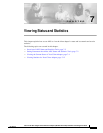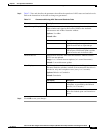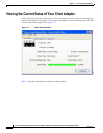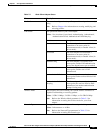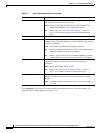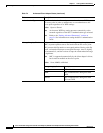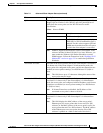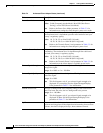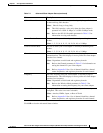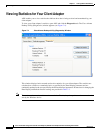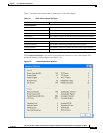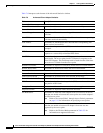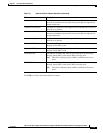
7-9
Cisco Aironet 802.11a/b/g Wireless LAN Client Adapters (CB21AG and PI21AG) Installation and Configuration Guide
OL-4211-03
Chapter 7 Viewing Status and Statistics
Viewing the Current Status of Your Client Adapter
QoS The type of quality of service that is currently being used by your client
adapter. QoS on wireless LANs (WLAN) provides prioritization of
traffic from the access point over the WLAN based on traffic
classification.
Value: None or WMM
QoS Description
None WMM standard QoS is not enabled.
WMM Wi-Fi Multimedia, a component of the
IEEE 802.11e WLAN standard for QoS, is
enabled. For this value to appear, QoS and
WMM must be enabled on the access point
to which the client adapter is associated.
Note WMM is supported automatically on the client adapter in the
software included in Install Wizard 2.0 or later. However, you
must enable the Windows QoS Packet Scheduler to ensure
WMM support. Follow the instructions in the “Enabling Wi-Fi
Multimedia” section on page 5-51 to enable the QoS Packet
Scheduler.
Associated AP Name The name of the access point to which your client adapter is associated.
It is shown only if the client adapter is in infrastructure mode, the
access point was configured with a name, and Aironet Extensions are
enabled (on access points running Cisco IOS Release 12.2(4)JA or
later).
Note This field shows up to 15 characters although the name of the
access point may be longer.
Associated AP IP Address The IP address of the access point to which your client adapter is
associated. It is shown only if the client adapter is in infrastructure
mode, the access point was configured with an IP address, and Aironet
Extensions are enabled (on access points running Cisco IOS Release
12.2(4)JA or later).
Note If Aironet Extensions are disabled, the IP address of the
associated access point is shown as 0.0.0.0.
Associated AP MAC Address The MAC address of the access point to which your client adapter is
associated. It is shown only if the client adapter is in infrastructure
mode.
Note This field displays the MAC address of the access point’s
Ethernet port (for access points that do not run Cisco IOS
software) or the MAC address of the access point’s radio (for
access points that run Cisco IOS software). The MAC address
of the Ethernet port on access points that run Cisco IOS
software is printed on a label on the back of the device.
Table 7-4 Advanced Client Adapter Status (continued)
Status Description



